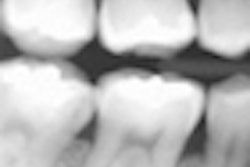Since 2D fit assessment techniques currently used in dentistry miss important information about the third dimension, researchers from the University of Erlangen have developed a new protocol to provide 3D information to enhance the virtual registration of digital restorations with abutments (Quintessence International, September 2011, Vol. 42:8, pp. 651-657).
They used CAD/CAM to produce 10 titanium single crown copings for five gypsum master casts each, representing a molar prepared for a full crown. An industrial noncontact scanner digitized the components, and registration of surface datasets was achieved using the new triple-scan protocol.
For statistical analysis and repeatability testing of the protocol, mean distances of the cement space of all copings on their respective abutments were measured three times.
Intraclass correlation coefficients that revealed an almost perfect coefficient for repeatability (p < 0.001) with a 95% confidence range, the researchers reported.
"The triple-scan protocol represents a reliable registration approach for surface datasets in dental applications and eliminates the limitations of conventional best-fit registration protocols when a cement space or gap is present between a restoration and its underlying abutment," the study authors concluded.



















